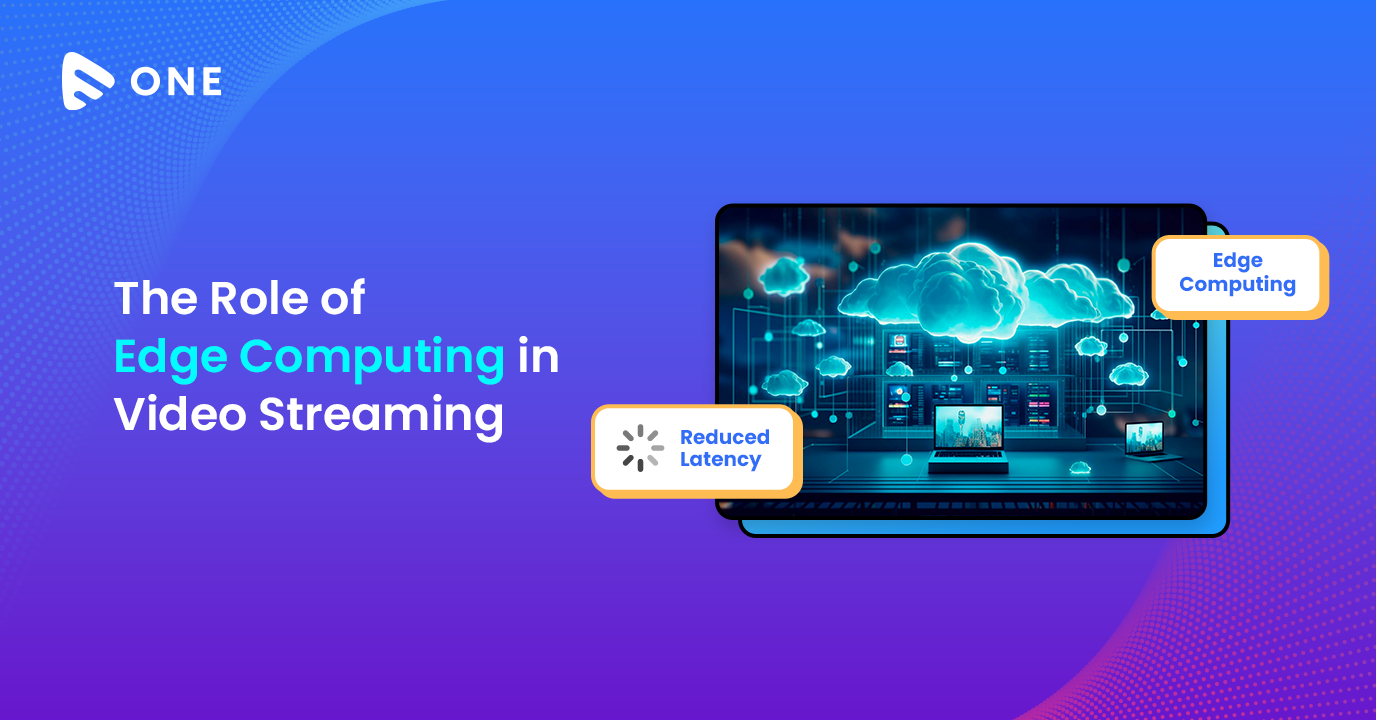In video streaming, where milliseconds of latency and uninterrupted playback are paramount, the role of edge computing emerges as a crucial component in ensuring seamless user experiences. Edge computing, a distributed computing paradigm that brings computation and data storage closer to the location where it is needed, has revolutionized the landscape of video streaming services.
Edge computing aims to reduce latency, improve bandwidth efficiency, and enhance overall performance by processing data closer to the end-user, rather than relying solely on centralized data centers. Understanding the significance of edge computing in video streaming necessitates a clear comprehension of its underlying principles and mechanisms.
As viewers demand high-definition content on a multitude of devices, traditional approaches to video streaming encounter challenges related to bandwidth limitations and network congestion. Edge computing addresses these challenges by decentralizing computational resources and strategically placing them at the network’s edge, closer to the point of consumption. This proximity minimizes the distance data must travel, resulting in reduced latency and improved responsiveness during video playback.
Let’s delve deeper for a better understanding!
What Is Edge Computing?
Edge computing refers to a distributed computing paradigm that brings data processing and storage closer to the location where it is needed, typically at or near the edge of the network. Unlike traditional cloud computing, which centralizes computational resources in remote data centers, edge computing decentralizes these resources and places them in closer proximity to end-users and their devices.
By processing data locally, at the edge of the network, edge computing reduces latency, minimizes bandwidth usage, and improves overall system performance. The primary goal of edge computing is to enhance the efficiency and responsiveness of data-intensive applications, such as IoT devices, real-time analytics, and content delivery networks.
Edge computing architecture typically involves deploying edge nodes or servers at strategic locations within the network, enabling faster data processing and decision-making without the need to transmit data to a centralized cloud infrastructure.
This distributed approach is particularly beneficial in scenarios where low latency, high availability, and real-time processing are critical requirements.
Edge Computing in Video Streaming: Origin & Evolution
Edge computing in video streaming has undergone an extensive journey, evolving from traditional centralized architectures to distributed systems that prioritize low latency, high performance, and scalability. The origin and evolution of edge computing in video streaming reflect the industry’s quest for enhanced user experiences and improved content delivery mechanisms.
Initially, video streaming relied heavily on centralized cloud infrastructures, where content was processed, stored, and distributed from remote data centers. While this approach facilitated the delivery of on-demand content to a global audience, it also introduced challenges such as latency, network congestion, and scalability limitations. As viewers demanded higher quality and real-time streaming experiences, the shortcomings of centralized architectures became increasingly apparent.
The emergence of edge computing marked a significant shift in video streaming paradigms. Recognizing the importance of proximity to end-users, content delivery networks (CDNs) began deploying edge servers and caching mechanisms at strategic locations closer to the network edge. This distributed architecture enabled faster content delivery, reduced latency, and improved overall performance, particularly for live streaming events and high-demand content.
The evolution of edge computing in video streaming was further propelled by advancements in network technologies, hardware capabilities, and software optimizations. Edge nodes equipped with powerful processors, solid-state storage, and caching algorithms became instrumental in processing and delivering video content with minimal delay. Moreover, the integration of machine learning algorithms and predictive analytics empowered edge nodes to dynamically adapt to changing network conditions and viewer preferences, ensuring optimal content delivery in real time.
Today, edge computing plays a central role in the video streaming ecosystem, facilitating a seamless and immersive viewing experience for millions of users worldwide. From live sports broadcasts to on-demand entertainment, edge computing enables streaming providers to deliver high-quality content with unparalleled reliability and responsiveness. As the demand for video streaming continues to soar, the evolution of edge computing remains integral to meeting the evolving needs of viewers and content providers alike, ushering in a new era of innovation and possibilities in the digital media landscape.
The Key Roles of Edge Computing in Video Streaming
Edge computing has emerged as a pivotal technology in video streaming, revolutionizing the way content is delivered, accessed, and consumed. Here are the key roles of edge computing in video streaming.
1. Low Latency Delivery
Latency, or the delay between data transmission and reception, is a critical factor in video streaming that directly impacts user experience. High latency can result in buffering, stuttering, and interruptions, detracting from the seamless viewing experience viewers expect. Edge computing addresses latency challenges by reducing the distance data must travel and minimizing processing times.
By deploying edge servers and caching mechanisms closer to end-users, video streaming providers can deliver content more efficiently. Edge servers store frequently accessed content locally, reducing the need to retrieve data from distant data centers. This proximity significantly reduces latency, enabling faster content delivery and smoother playback.
For live streaming events, where real-time interaction is essential, edge computing ensures minimal delay between the broadcast and viewer’s screen, enhancing engagement and immersion.
2. Enhanced Quality of Service (QoS)
Quality of service encompasses various factors that contribute to the overall viewing experience, including video resolution, bitrate, audio quality, and reliability. Edge computing plays a pivotal role in enhancing QoS by optimizing content delivery, mitigating network congestion, and dynamically adjusting streaming parameters based on network conditions and device capabilities.
With edge computing, video streaming providers can implement adaptive bitrate streaming (ABR) algorithms that monitor network bandwidth and device capabilities in real time. By dynamically adjusting the video resolution and bitrate to match the viewer’s network speed and screen size, edge computing ensures a consistent and uninterrupted viewing experience across diverse devices and network conditions.
Additionally, edge servers can perform transcoding and format conversion tasks on the fly, optimizing content for seamless playback on a wide range of devices and platforms.
Furthermore, edge computing enables personalized content delivery based on user preferences, location, and viewing history. By leveraging edge analytics and machine learning algorithms, streaming providers can deliver targeted recommendations, personalized playlists, and tailored content offerings, enhancing user engagement and satisfaction.
3. Bandwidth Optimization
Bandwidth constraints pose significant challenges in video streaming, especially in regions with limited internet infrastructure or during peak usage periods. Edge computing addresses bandwidth optimization by reducing the amount of data transmitted over the network and optimizing content delivery for maximum efficiency.
Edge computing plays a vital role in upholding Network Right by employing caching mechanisms to store and serve content locally, minimizing the need for repetitive data transfers across the network. By caching popular videos, software updates, and streaming segments at the network edge, edge computing reduces bandwidth consumption and alleviates network congestion.
Moreover, edge servers can perform content prefetching and predictive caching based on user behavior and viewing patterns, anticipating demand and proactively delivering content to edge nodes before it is requested.
Furthermore, edge computing facilitates content delivery through multicast and peer-to-peer (P2P) distribution mechanisms, enabling efficient distribution of large-scale events and live streams to a massive audience. By leveraging multicast protocols and P2P networks, edge computing optimizes bandwidth usage and ensures scalable delivery of high-demand content without overburdening the network infrastructure.
4. Enhancing Content Delivery Efficiency
Content Delivery Networks (CDNs) have become integral to modern digital content delivery strategies, facilitating faster, more reliable, and scalable distribution of web content, streaming media, and software updates. Integrating CDNs into edge computing architectures enhances content delivery efficiency by leveraging distributed caching, optimized routing, and enhanced reliability mechanisms.
Leveraging Distributed Caching
CDN integration within edge computing architectures involves deploying CDN edge servers at strategic locations closer to end-users. These edge servers cache frequently accessed content, such as web pages, images, videos, and software files, reducing the distance data needs to travel and improving content availability. By caching content closer to users, CDNs minimize latency and optimize bandwidth usage, resulting in faster load times and smoother user experiences.
Distributed caching ensures that content is served from the nearest CDN edge server, reducing the load on origin servers and improving overall system performance. As users request content, CDN edge servers dynamically retrieve and deliver cached content based on user location, network conditions, and content popularity. This distributed caching approach accelerates content delivery, mitigates network congestion, and enhances the scalability of digital services.
Optimized Routing and Load Balancing
CDN integration enhances content delivery efficiency through optimized routing and load balancing algorithms. CDN edge servers use intelligent routing techniques to determine the optimal path for content delivery, considering factors such as network latency, server availability, and traffic conditions. By directing user requests to the nearest and most responsive edge server, CDNs minimize latency and ensure reliable content delivery across diverse geographic regions.
Load balancing mechanisms within CDNs distribute incoming traffic across multiple edge servers, preventing any single server from becoming overwhelmed by excessive demand. By dynamically allocating resources and adjusting traffic distribution in real time, CDNs optimize server utilization, improve system reliability, and maintain consistent performance under varying load conditions. Load balancing algorithms prioritize efficient resource utilization, minimize response times, and enhance overall service availability for end-users.
Enhanced Reliability and Security
CDN integration enhances content delivery reliability and security by providing redundancy, failover mechanisms, and built-in security features. CDN edge servers replicate content across multiple geographically dispersed locations, ensuring high availability and resilience against network failures or server outages. In the event of a server failure or network disruption, CDN edge servers seamlessly redirect traffic to alternate servers, minimizing service interruptions and maintaining continuity of content delivery.
CDNs also offer robust security features, including Distributed Denial of Service (DDoS) protection, SSL encryption, and web application firewalls. By filtering malicious traffic, encrypting data in transit, and mitigating potential security threats, CDNs safeguard content and infrastructure from cyber attacks and unauthorized access. Security measures implemented at the CDN edge help protect sensitive information, preserve data integrity, and maintain trust in digital services.
5. Real-Time Streaming
Real-time streaming refers to the continuous transmission and playback of audio, video, or multimedia content over the internet with minimal delay. It enables users to access live events, broadcasts, and interactive experiences in real time, fostering engagement and connectivity across diverse platforms and devices.
Real-time streaming technologies leverage protocols such as Real-Time Messaging Protocol (RTMP), HTTP Live Streaming (HLS), and Dynamic Adaptive Streaming over HTTP (DASH) to deliver content seamlessly across various networks and devices. Whether it’s live sports events, concerts, news broadcasts, or interactive gaming sessions, real-time streaming enables users to experience events as they unfold, fostering a sense of immediacy and immersion.
One of the key advantages of real-time streaming is its ability to engage audiences in interactive experiences, such as live chats, polls, and audience participation. Streaming platforms often integrate interactive features that enable users to engage with content creators, share feedback, and participate in real-time discussions, fostering community engagement and collaboration.
Moreover, real-time streaming has revolutionized various industries, including entertainment, education, and e-commerce. It enables content creators, educators, and businesses to reach global audiences, deliver immersive experiences, and drive engagement and monetization opportunities.
However, real-time streaming poses challenges such as latency, network congestion, and scalability requirements. To ensure smooth and uninterrupted streaming experiences, content providers must leverage advanced streaming infrastructure, content delivery networks (CDNs), and optimization techniques to minimize latency and maximize reliability.
6. Network Load Reduction
Network load reduction refers to the process of optimizing network resources to minimize congestion, improve performance, and enhance overall efficiency. In today’s digital landscape, where data consumption and network traffic continue to soar, network load reduction strategies are essential for maintaining a reliable and responsive network infrastructure.
One of the primary methods for network load reduction is traffic shaping, which involves prioritizing and managing data traffic to ensure equitable distribution of network resources. Traffic shaping techniques prioritize critical applications, such as voice and video communications, while allocating bandwidth based on user requirements and network policies. By prioritizing essential traffic and limiting non-essential data transfers, traffic shaping helps optimize network performance and reduce congestion during peak usage periods.
Another effective approach for network load reduction is content caching and compression. Content caching involves storing frequently accessed data, such as web pages, images, and multimedia content, at strategic locations within the network. By caching content closer to end-users, organizations can reduce the need for repetitive data transfers and minimize latency, improving content delivery speed and user experience.
Additionally, content compression techniques, such as gzip compression for web content, reduce the size of data packets transmitted over the network, optimizing bandwidth usage and accelerating content delivery.
Furthermore, network load reduction strategies leverage technologies such as content delivery networks (CDNs) and edge computing to distribute content and processing tasks across distributed servers and edge nodes.
CDNs deploy caching servers at strategic locations worldwide, enabling faster content delivery and reducing the load on origin servers. Similarly, edge computing platforms leverage distributed computing resources at the network edge to process data and deliver services closer to end-users, minimizing latency and network congestion.
7. Dynamic Scalability
Dynamic scalability refers to the ability of a system or application to adjust its capacity and resources dynamically in response to changing workload demands. In dynamic scalability, resources such as computing power, storage, and bandwidth are allocated and de-allocated automatically based on real-time demand, optimizing performance and efficiency while minimizing costs.
Cloud computing platforms and virtualization technologies are instrumental in enabling dynamic scalability for modern applications and services. Through cloud computing, organizations can leverage scalable infrastructure resources on-demand, scaling up or down as needed to accommodate fluctuations in user traffic, processing requirements, and storage needs.
One of the key benefits of dynamic scalability is its ability to ensure optimal performance and reliability during peak usage periods. For example, during periods of high user activity, such as Black Friday sales events or live streaming broadcasts, dynamic scalability enables systems to automatically provision additional resources to handle increased traffic and maintain responsiveness.
Moreover, dynamic scalability enhances cost-effectiveness by enabling organizations to pay only for the resources they use. Instead of over-provisioning resources to accommodate peak loads, organizations can scale resources dynamically, reducing operational costs and maximizing resource utilization efficiency.
Dynamic scalability is particularly valuable for applications and services that experience unpredictable or fluctuating workloads. For instance, web applications, e-commerce platforms, and online gaming services may experience sudden spikes in user activity during promotional events or product launches. With dynamic scalability, these platforms can seamlessly scale resources to meet demand and ensure a consistent user experience without disruptions or performance degradation.
Furthermore, dynamic scalability enhances agility and flexibility in adapting to changing business requirements and market conditions. By enabling rapid resource provisioning and scaling, organizations can respond quickly to evolving customer needs, competitive pressures, and technological advancements, maintaining a competitive edge in the digital landscape.
The Bottom Line: The Future of Edge Computing in Video Streaming
The future of edge computing in video streaming holds immense promise for transforming the way content is delivered, accessed, and consumed across diverse platforms and devices. As technology continues to evolve and user expectations evolve, edge computing is poised to play a pivotal role in enhancing the efficiency, scalability, and reliability of video streaming services.
One of the key trends shaping the future of edge computing in video streaming is the proliferation of ultra-low latency streaming experiences. With the rising demand for real-time interaction and immersive content, edge computing enables streaming providers to deliver ultra-low latency streams with minimal delay.
By leveraging edge nodes and distributed computing resources, video streaming platforms can process and deliver content closer to end-users, reducing latency and improving responsiveness for live events, gaming, and interactive experiences.
Furthermore, edge computing empowers streaming providers to deliver personalized and context-aware content recommendations and experiences. By analyzing user preferences, viewing habits, and real-time interactions, edge computing enables streaming platforms to deliver targeted content recommendations, personalized playlists, and tailored experiences that resonate with individual users. This personalized approach enhances user engagement, fosters brand loyalty, and drives retention in an increasingly competitive streaming landscape.
Are you looking for a robust solution to launch your own branded video streaming platform? With Muvi One, you can do it even without writing a single line of code. Furthermore, it offers a bunch of competitive features like robust cloud infrastructure, multiple monetization models, multi-DRM security, audience engagement tools, SEO optimization tools and many more. Take a 14-day free trial to get started!
















Add your comment